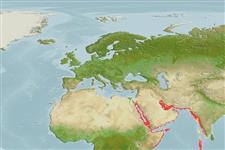>
Blenniiformes (Blennies) >
Blenniidae (Combtooth blennies) > Salariinae
Etymology: Antennablennius: Latin, antenna, antemna = sensory organ; in Aristotle = horns of insects + Greek, blennios = mucus (Ref. 45335).
More on author: Klunzinger.
Environment: milieu / climate zone / djupintervall / distribution range
Ekologi
marina bottenlevande. Tropical
Western Indian Ocean: entire Arabian Peninsula from the northern Red Sea to the Persian Gulf.
Size / Vikt / Age
Könsmognad: Lm ? range ? - ? cm
Max length : 6.5 cm TL hane/ej könsbestämd; (Ref. 11441)
Short description
Bestämningsnycklar | Morfologi | Morfometri
Taggstrålar i ryggfenan (totalt) : 12 - 13; Mjukstrålar i ryggfenan (totalt) : 16 - 20; Taggstrålar i analfenan: 2; Mjukstrålar i analfenan: 19 - 21.
Body shape (shape guide): elongated.
Inshore species found on rocky bottoms. Oviparous. Eggs are demersal and adhesive (Ref. 205), and are attached to the substrate via a filamentous, adhesive pad or pedestal (Ref. 94114). Larvae are planktonic, often found in shallow, coastal waters (Ref. 94114).
Life cycle and mating behavior
Könsmognad | Reproduktion | Lek | Ägg | Fecundity | Larver
Oviparous, distinct pairing (Ref. 205).
Randall, J.E., 1995. Coastal fishes of Oman. University of Hawaii Press, Honolulu, Hawaii. 439 p. (Ref. 11441)
IUCN Red List Status (Ref. 130435: Version 2025-1)
Threat to humans
Harmless
Human uses
Verktyg
Special reports
Download XML
Internet-källor
Estimates based on models
Preferred temperature (Ref.
123201): 24.8 - 29.3, mean 27.1 °C (based on 270 cells).
Phylogenetic diversity index (Ref.
82804): PD
50 = 0.5020 [Uniqueness, from 0.5 = low to 2.0 = high].
Bayesian length-weight: a=0.00776 (0.00356 - 0.01695), b=3.00 (2.81 - 3.19), in cm total length, based on LWR estimates for this (Sub)family-body shape (Ref.
93245).
Resiliens (Ref.
120179): Hög, lägsta populationsfördubblingstid mindre än 15 månader (Preliminary K or Fecundity.).
Fishing Vulnerability (Ref.
59153): Low vulnerability (10 of 100).
🛈
